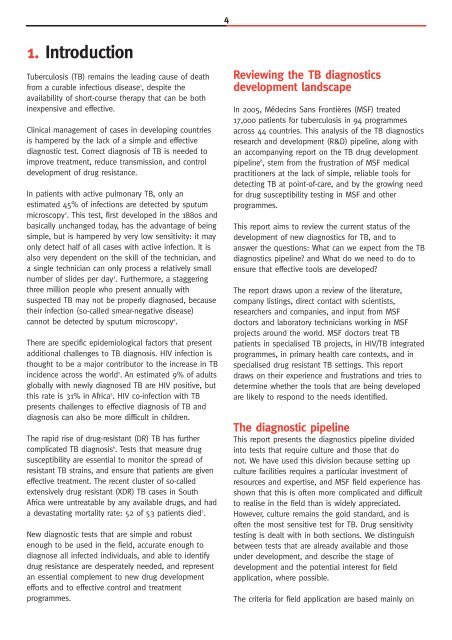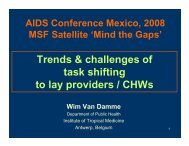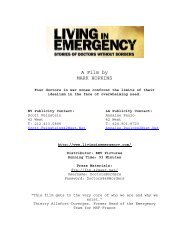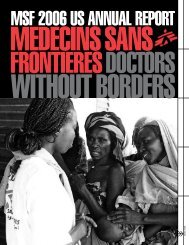Tuberculosis Diagnosis and Drug Sensitivity Testing
Tuberculosis Diagnosis and Drug Sensitivity Testing
Tuberculosis Diagnosis and Drug Sensitivity Testing
You also want an ePaper? Increase the reach of your titles
YUMPU automatically turns print PDFs into web optimized ePapers that Google loves.
1. Introduction<br />
<strong>Tuberculosis</strong> (TB) remains the leading cause of death<br />
from a curable infectious disease 1 , despite the<br />
availability of short-course therapy that can be both<br />
inexpensive <strong>and</strong> effective.<br />
Clinical management of cases in developing countries<br />
is hampered by the lack of a simple <strong>and</strong> effective<br />
diagnostic test. Correct diagnosis of TB is needed to<br />
improve treatment, reduce transmission, <strong>and</strong> control<br />
development of drug resistance.<br />
In patients with active pulmonary TB, only an<br />
estimated 45% of infections are detected by sputum<br />
microscopy 2 . This test, first developed in the 1880s <strong>and</strong><br />
basically unchanged today, has the advantage of being<br />
simple, but is hampered by very low sensitivity: it may<br />
only detect half of all cases with active infection. It is<br />
also very dependent on the skill of the technician, <strong>and</strong><br />
a single technician can only process a relatively small<br />
number of slides per day 3 . Furthermore, a staggering<br />
three million people who present annually with<br />
suspected TB may not be properly diagnosed, because<br />
their infection (so-called smear-negative disease)<br />
cannot be detected by sputum microscopy 4 .<br />
There are specific epidemiological factors that present<br />
additional challenges to TB diagnosis. HIV infection is<br />
thought to be a major contributor to the increase in TB<br />
incidence across the world 2 . An estimated 9% of adults<br />
globally with newly diagnosed TB are HIV positive, but<br />
this rate is 31% in Africa 5 . HIV co-infection with TB<br />
presents challenges to effective diagnosis of TB <strong>and</strong><br />
diagnosis can also be more difficult in children.<br />
The rapid rise of drug-resistant (DR) TB has further<br />
complicated TB diagnosis 6 . Tests that measure drug<br />
susceptibility are essential to monitor the spread of<br />
resistant TB strains, <strong>and</strong> ensure that patients are given<br />
effective treatment. The recent cluster of so-called<br />
extensively drug resistant (XDR) TB cases in South<br />
Africa were untreatable by any available drugs, <strong>and</strong> had<br />
a devastating mortality rate: 52 of 53 patients died 7 .<br />
New diagnostic tests that are simple <strong>and</strong> robust<br />
enough to be used in the field, accurate enough to<br />
diagnose all infected individuals, <strong>and</strong> able to identify<br />
drug resistance are desperately needed, <strong>and</strong> represent<br />
an essential complement to new drug development<br />
efforts <strong>and</strong> to effective control <strong>and</strong> treatment<br />
programmes.<br />
4<br />
Reviewing the TB diagnostics<br />
development l<strong>and</strong>scape<br />
In 2005, Médecins Sans Frontières (MSF) treated<br />
17,000 patients for tuberculosis in 94 programmes<br />
across 44 countries. This analysis of the TB diagnostics<br />
research <strong>and</strong> development (R&D) pipeline, along with<br />
an accompanying report on the TB drug development<br />
pipeline 8 , stem from the frustration of MSF medical<br />
practitioners at the lack of simple, reliable tools for<br />
detecting TB at point-of-care, <strong>and</strong> by the growing need<br />
for drug susceptibility testing in MSF <strong>and</strong> other<br />
programmes.<br />
This report aims to review the current status of the<br />
development of new diagnostics for TB, <strong>and</strong> to<br />
answer the questions: What can we expect from the TB<br />
diagnostics pipeline? <strong>and</strong> What do we need to do to<br />
ensure that effective tools are developed?<br />
The report draws upon a review of the literature,<br />
company listings, direct contact with scientists,<br />
researchers <strong>and</strong> companies, <strong>and</strong> input from MSF<br />
doctors <strong>and</strong> laboratory technicians working in MSF<br />
projects around the world. MSF doctors treat TB<br />
patients in specialised TB projects, in HIV/TB integrated<br />
programmes, in primary health care contexts, <strong>and</strong> in<br />
specialised drug resistant TB settings. This report<br />
draws on their experience <strong>and</strong> frustrations <strong>and</strong> tries to<br />
determine whether the tools that are being developed<br />
are likely to respond to the needs identified.<br />
The diagnostic pipeline<br />
This report presents the diagnostics pipeline divided<br />
into tests that require culture <strong>and</strong> those that do<br />
not. We have used this division because setting up<br />
culture facilities requires a particular investment of<br />
resources <strong>and</strong> expertise, <strong>and</strong> MSF field experience has<br />
shown that this is often more complicated <strong>and</strong> difficult<br />
to realise in the field than is widely appreciated.<br />
However, culture remains the gold st<strong>and</strong>ard, <strong>and</strong> is<br />
often the most sensitive test for TB. <strong>Drug</strong> sensitivity<br />
testing is dealt with in both sections. We distinguish<br />
between tests that are already available <strong>and</strong> those<br />
under development, <strong>and</strong> describe the stage of<br />
development <strong>and</strong> the potential interest for field<br />
application, where possible.<br />
The criteria for field application are based mainly on





